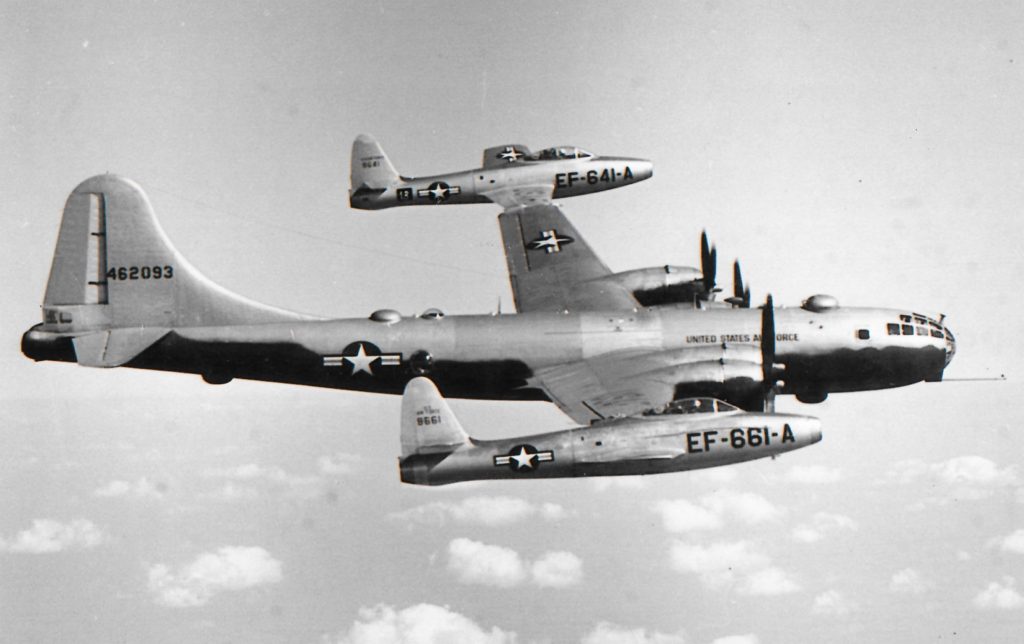
The Boeing ETB-29A with the two EF-84Bs coupled to the wing-tips
Caught by the Wing-Tip
by Clarence E. “Bud” Anderson
WINGTIP COUPLING evolved from the aerodynamic invention of Dr. Richard Vogt, a German scientist who came to America after World War II. The basic concept was a method of increasing the range of an aircraft by attaching two “free floating” panels, carrying fuel, as extensions to the wingtips. This could be accomplished without undue structural weight penalties, provided the extensions were free to articulate and were self-supported by their own aerodynamic lift. The added wingtip floating panels increase the aspect ratio of the basic wing configuration which provides a significant induced drag reduction. Therefore, as the theory goes, the extra fuel is now being carried free by the more efficient wing and the range of the basic aircraft is increased considerably by the extra fuel.
Logically, other uses of this unusual concept became apparent; for example, two escort fighters might be carried along “free” on a large bomber aircraft, without sacrifice of any bomber range. To be feasible, the wingtip extensions, whatever they were, would have to be kept properly aligned, preferably by a simple and automatic fight control system. There is also the problem of how such a configuration could be handled on the ground in the case of fuel carrying extensions. How would the extensions be supported without airflow to hole them up? Perhaps by the use of a retractable outrigger landing gear, but what about runway width requirements? And the big question: what about the stability and control problems that might be induced by such a configuration; could the extensions be easily controlled? Many questions also are immediately apparent in the case of tow fighters being towed by a bomber. How difficult would it be to make mid-air couplings? Would there be stability and control problems? What about pilot fatigue, and could an automatic system be developed to control the coupled fighters?
Research revealed that some early experiments were made in 1944-45 by the Germans. The tests are not thoroughly documented, but it is known that two light planes of equal size were flown in coupled flight. The method used to accomplish the coupling was to connect the two aircraft with a rope or cable through the wingtips. The two aircraft made separate take-offs with the rope having enough play to allow routine formation flying. Once at a safe altitude, the rope was winched in by one of the aircraft until the wingtip joints snapped into place. The connection was like a universal joint. The aircraft were flown much as if in formation, and some wide turns and changes in altitude were made. The project was dropped by the German Air Ministry through apparent lack of interest and it is not clear why the experiments were conducted.
At Wright Field, Ohio, starting in the late 1940s, the concept was given new life through Dr. Vogt’s proposals to the US Air Force. A simple project to investigate air-to-air coupling was conceived and accomplished by Wright Field to determine the feasibility of the concept, involving a C-47 and a Q-14.
Meanwhile, a full-scale program was developed around a B-29 towing two F-84D straight-wing fighters. Republic Aviation Corporation was awarded a contract to design, build and evaluate the unusual combination. This was a rather complex project involving a mechanical automatic control system, wingtip seals, and flight test instrumentation to provide the necessary data to prove the concept quantitatively.
At this point, I would like to mention another German who also came to Wright Field after World War II, Ben Hohmann. He was a down-to-earth, practical engineer who was able to make projects work. His experience, knowledge and ideas were used on many of the mechanical features of the coupling mechanism. Further, he was a skilled pilot and flew as a C-47 crew member on many experimental test flights. He made great contributions to both the feasibility and the full-scale coupling projects.
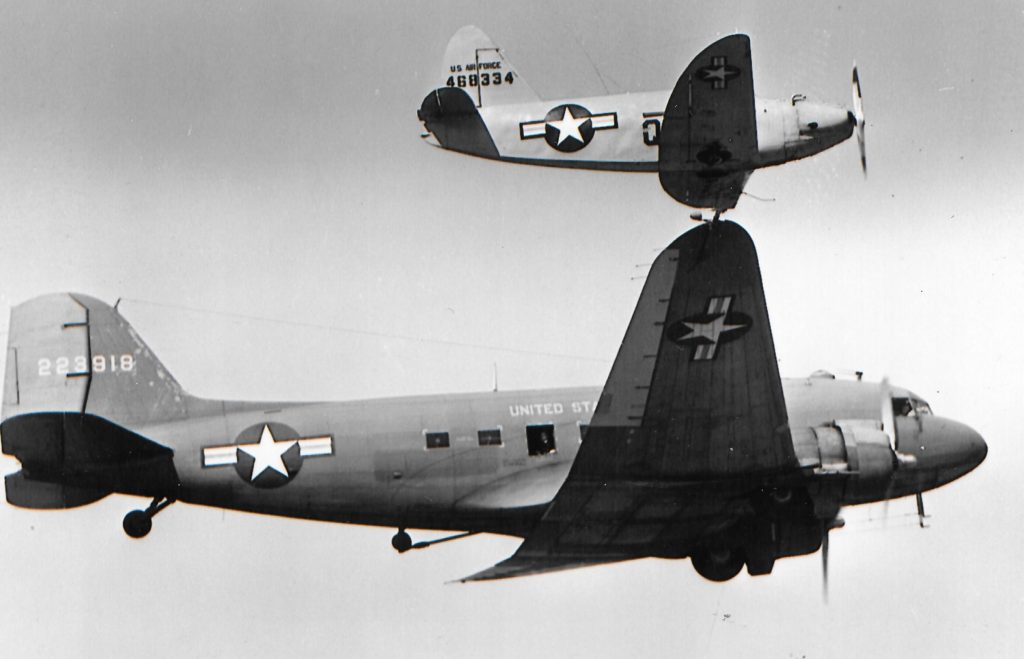
The Culver Q-14 coupled to the Douglas C-47 during one of the first hook-ups in the series of tests flown by the author.
The C-47/Q-14 Experiments
In 1949, work began on the modification of a Douglas C-47A cargo aircraft and a small Q14B target plane, similar to the general aviation Culver Cadet. These two aircraft were chosen because they had approximately the same mass and span ratio as the full-scale B-29/F-84 project. This was to be a simple, quick, low-cost test to get some answers on the feasibility of air-to-air couplings.
In the interest of simplicity, the coupling device was a single-joint attachment which permitted three degrees of freedom for the Q-14. A small ring was placed on a short boom attached to the right wingtip of the C-47, and only local reinforcement was necessary since the Q-14 would be supported by its own aerodynamic lift. A lance was mounted on the left wingtip of the mechanism was required since drag would keep the aircraft in place. Of course, this added a minor complication requiring the Q-14 to “back” into the ring, which was a little unnatural. To uncouple, the throttle would be advanced and the Q-14 would fly forward out of the ring. There was also an emergency release that could be activated inside the C-47, which would immediately release the ring from the wingtip boom providing instant separation.
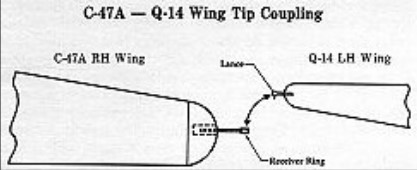
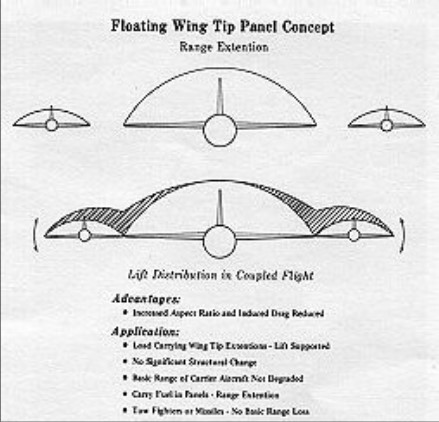
The initial attempt to couple was made on 19 August, 1949, at Wright Field, Ohio, and it proved to be an interesting experiment. There was considerable apprehension about the stability of the Q-14, even if coupling could be accomplished. Once coupled, it was hoped that position could be maintained by use of ailerons; however, there was some doubt and it was reasoned that the elevator might be the primary control. Since this was an inexpensive quick feasibility test, no wind tunnel or computer studies had been accomplished. In fact, since no one could predict with any certainty what would happen, we all anticipated the unexpected.
Preliminary flights in close proximity to the C-47 tip with the coupling mechanism installed, revealed the strong vortex airflow about the wingtip, which made precise close formation flight quite difficult. For the initial try, the C-47 climbed to an altitude of 8,000 feet for safety considerations. At that altitude the Q-14 had little or no excess power for maneuvering in an out of position, and this proved to be a problem. At this time the engagement ring was positioned 3 inches in from the wingtip.
The initial attempt to couple was quite difficult, because of the strong wingtip vortex airflow and lack of reserve power to maneuver the lance backwards into the ring. It was like trying to thread a needle in the middle of a fire hose. Uncertainty as to what might happen once the coupling was accomplished also could have contributed to the difficulty. After about 30 minutes of attempting to make a smooth, subtle engagement I decided that the only way to couple was to line up as close as possible and then reduce power faster than really desirable. This worked, and upon contact the Q-14 immediately dropped to a 90-degree nose down position in relation to the C-47 wingtip. This didn’t seem right, so power was advance for immediate disengagement. The whole thing happened in a few seconds. No further attempts were made that day, since a slight bend was observed in the C-47 wingtip.
After talking it over, several recommendations resulted. The engagement ring was moved about 19 inches out on the wingtip boom in order to reduce the effect of the wingtip vortex. Further, there was now a feeling that the ailerons were ineffective and that we would have made a smooth engagement keeping the power up until we could find out how to control the Q-14 about the engagement point.
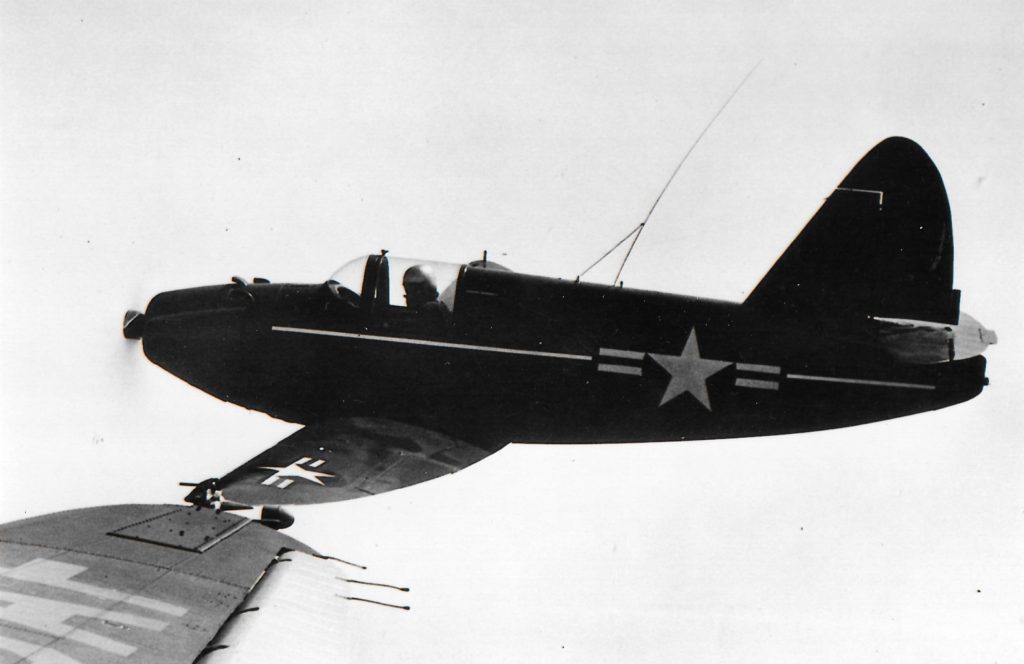
The Culver Q-14 attached to and photographed from the C-47.
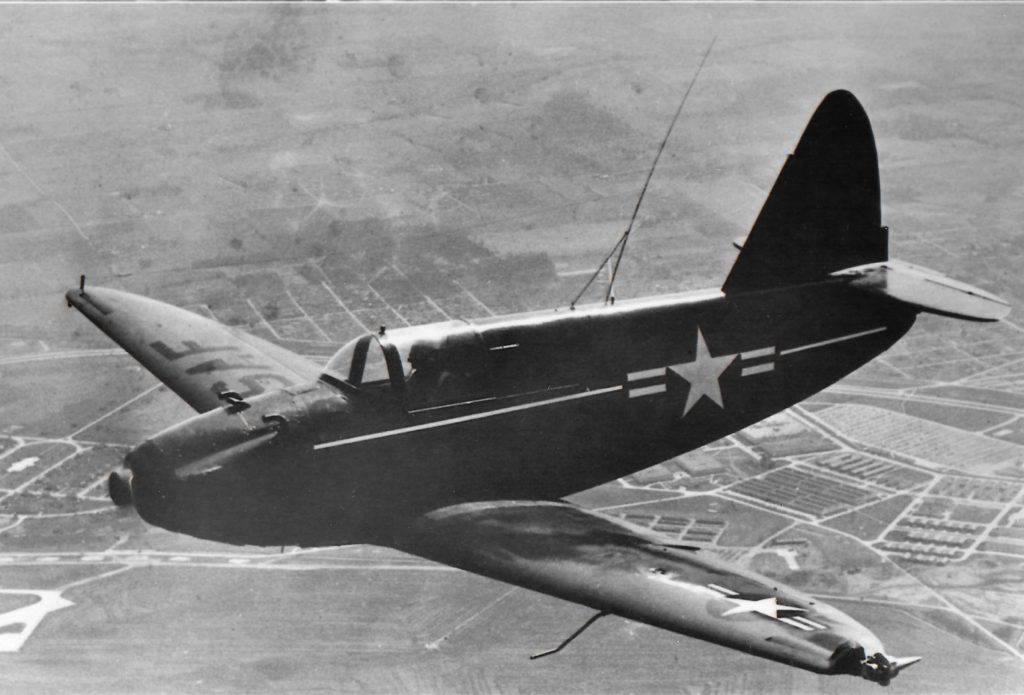
Q-14 in free flight, showing the coupling at the wing tip. The Q-14 was better known as the PQ-14 a target drone version of the pre-war Culver Cadet: the war-time PQ designation category was changed to Q by the USAF in 1948.
So on 7 October, 1949, we tried again. After considerable maneuvering, a successful coupling was made. This time power was only partially reduced, and it was found that the elevator was a primary control. At first, it was difficult to adjust to the use of elevator for roll control since the normal reaction was to use ailerons for roll about the coupled point. Four separate couplings were made on that date and the longest coupled flight was five minutes in duration.
After that flight, and as experience was gained, coupled flight became quite easy and almost routine. We found that the best technique for this combination was to make the hook-up at the lowest altitude where ever the air was smooth. The C-47 would stabilize at 95 knots, which gave the Q-14 adequate reserve power to maneuver in and out of position. Couplings became very easy, and with the increased experience, average time required to hook-up was somewhere between 10 and 30 seconds. Once hooked up, power was reduced to idle and control of the Q-14 was maintained by elevator exclusively. The ailerons were almost completely ineffective, and full aileron could easily be overridden by a very slight elevator movement. Once coupled, the C-47 could increase airspeed to a normal cruise of around 120 knots, where coupled stability actually improved. At that point the C-47 could do about anything that was normal – roll, climb, and dive in smooth air, turbulence, or weather. Even night couplings were made as part of the test program.
In the Q-14, hands-off flying was never possible for more than a few seconds. Since the Q-14 was basically a remote-controlled target aircraft, it had an autopilot system. Attempts were made to tie in autopilot elevator control with a flap-angle-limit microswitch sensor, but this was largely unsuccessful and beyond the original scope of the program. We even disconnected the inboard aileron, since it works against you, to see if the single outboard aileron could provide a better flap angle control. Roll rate improved slightly with the use of the single aileron, but control was still inadequate. To prove a point, the engagement ring on the C-47 wingtip was moved back to the original 3-inch position, and successful couplings were demonstrated under the influence of the stronger wingtip vortex. One point of interest was that once the Q-14 pilot gained full confidence, he could maintain position by flying instruments, if he so desired. All you had to do was to watch the turn/bank indicator and keep the ball centered with the elevator.
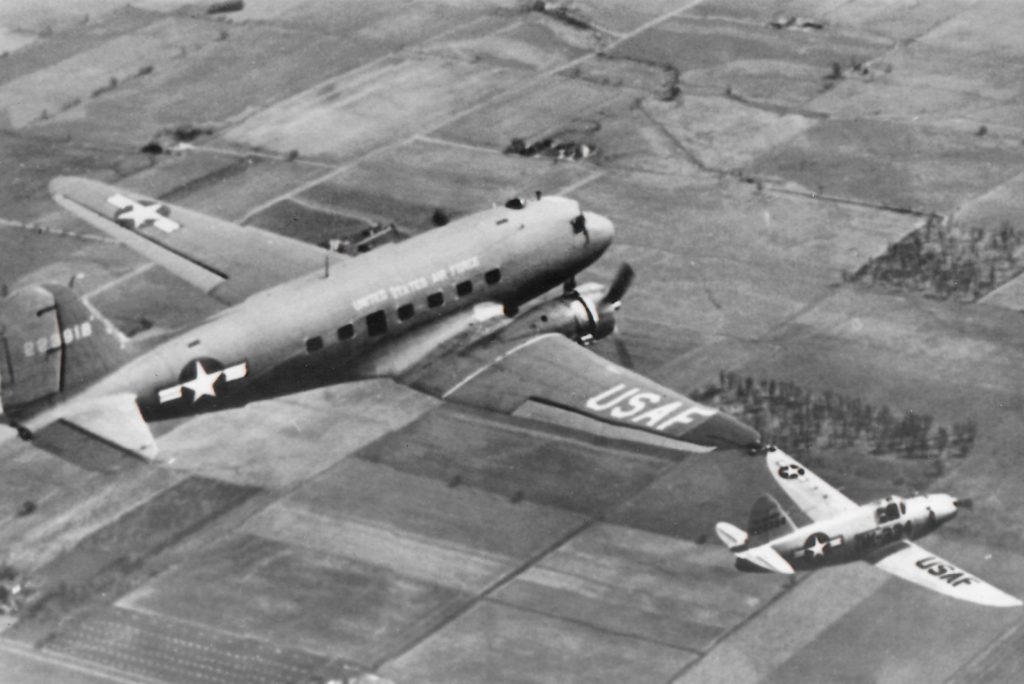
Another view of the C-47/Q14 combination in flight. As recorded in the accompanying account, a total of 231 couplings was made by this combination, with 17 different pilots, demonstrating the technique involved no serious difficulties.
The documented flight tests conducted up to October 1950 are summarized as follows:
• 231 wingtip couplings
• 28:35 total coupled flight hours
• 17 pilots familiarized with technique
• 56-night couplings (2:09 hours total)
• Longest coupled flight – 4:08 hours
• Coupled flight proved feasible
• Smooth air required to couple
• Pilots could be trained
• Elevator is primary control (ailerons ineffective)
• No performance data gathered
A large sampling of pilots was taken – mostly fighter pilots, but some multi-engine pilots were used also. Only one pilot failed to make a mid-air coupling. Night coupling proved to be no problem, as did weather flying. This project gave us confidence that couplings could be made under controlled experimental conditions, but there were many questions, both technical and operational, that needed answers. Moreover, the nature of these tests was such that no performance data were obtained to validate the concept. Additional undocumented couplings were accomplished later as more pilots were checked out, and the C-47/Q-14 combination was later used as a warm-up for the full-scale B-29/F-84 test program.
B-29/F-84 wingtip towing
In the summer of 1950, the hardware for the full-scale B-29/F-84 experiments (Project MX1016) was ready for flight testing. This effort was through contract to the Republic Aviation Corporation on Long Island, NY, and called for the modification of a standard four-engine propeller-driven B-29A bomber to permit the in-flight towing of two straight-wing F-84D jet fighters. The test program was planned to demonstrate the full-scale feasibility of this concept and to collect data to validate the drag-reducing benefits of wingtip towing.
The modification to the two F-84 fighters was relatively simple, consisting of installation of a forward-facing lance which was used to engage the B-29 receiver. The oblong tip of the lance rotated through 90 degrees to form a lock when fully inserted. There was a hydromechanical interconnect between the lance shaft and the F-84 aileron control. It was hoped that this simple method, which was based on a ratio of lance rotation or flap angle to aileron movement, would provide automatic control.
The system could be manually overridden by the F-84 pilot or easily disconnected if desired. As a result of the C-47/Q-14 tests, there was doubt that the ailerons could provide the necessary control power. The F-84 was free in pitch, roll and yaw about the coupling point at the wingtip.
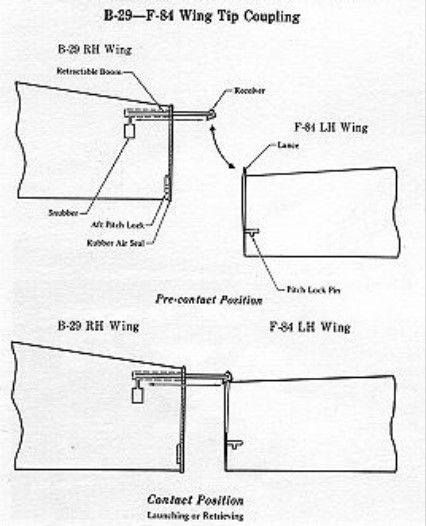
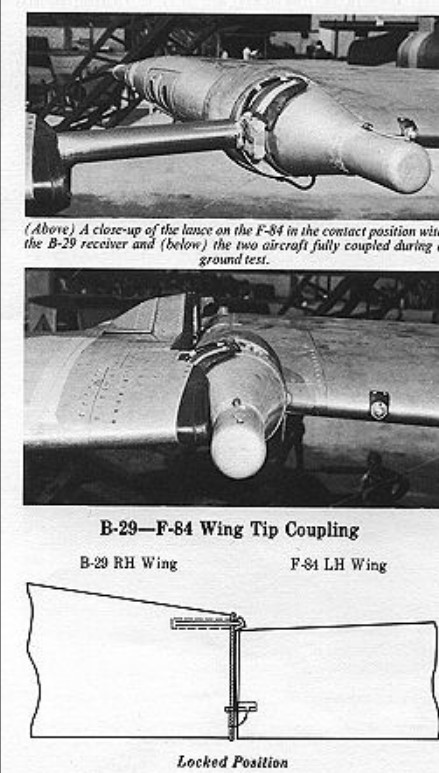
The retrieving cylinder was retracted inboard to the locked position of towing. The aft locking mechanism matched up and an arm moved out from the B-29 over a pin in the F-84. At this point, the hydraulic snubber was cut out, since the F-84 was now fixed in pitch and yaw, allowing only a flapping action or roll about the longitudinal axis between the wingtips. An emergency release system of explosive bolts was installed and could be activated manually from either aircraft or automatically if preset flapping angle limits were exceeded.
The B-29 and the right-hand F-84 were fully instrumented from development investigation, and to collect performance data. The left-hand F-84 had all the modifications, but no data instrumentation was installed.
Test results
The initial attempt to couple was made on 21 July, 1950, when the right-hand F-84 made four successful engagements over Long Island. The lance-aileron interconnect was disconnected for this flight, and the B-29 aft lock was replaced with a flat plate to check the match-up with the F-84. One full retrieve and launch cycle was made during this initial flight. We discovered that this was a much more delicate operation than the Q-14/C-47 combination. Air circulation around the wingtip still presented a problem. The lag in jet engine thrust response, also added a new obstacle to a precise wingtip coupling. A smooth, steady line-up and insertion of the lance produced satisfactory hook-ups. However, if the receiver was engaged with a sharp solid contact, a lateral structural oscillation would be induced along the with the B-29 wing. If this was not stopped immediately or corrective action got out of phase, the oscillation would increase in amplitude and the F-84 would have to be released at once. This raised some concern about the possibility of flying in any kind of rough air. The C-47 was very rigid and no structural oscillations were noticed, even in turbulence. The B-29 wing, on the other hand, was quite flexible, and it became rather nerve-racking at times to keep things under control. This also provided quite a motivating factor for making a precise engagement. As a consequence, we never flew in rough air intentionally.
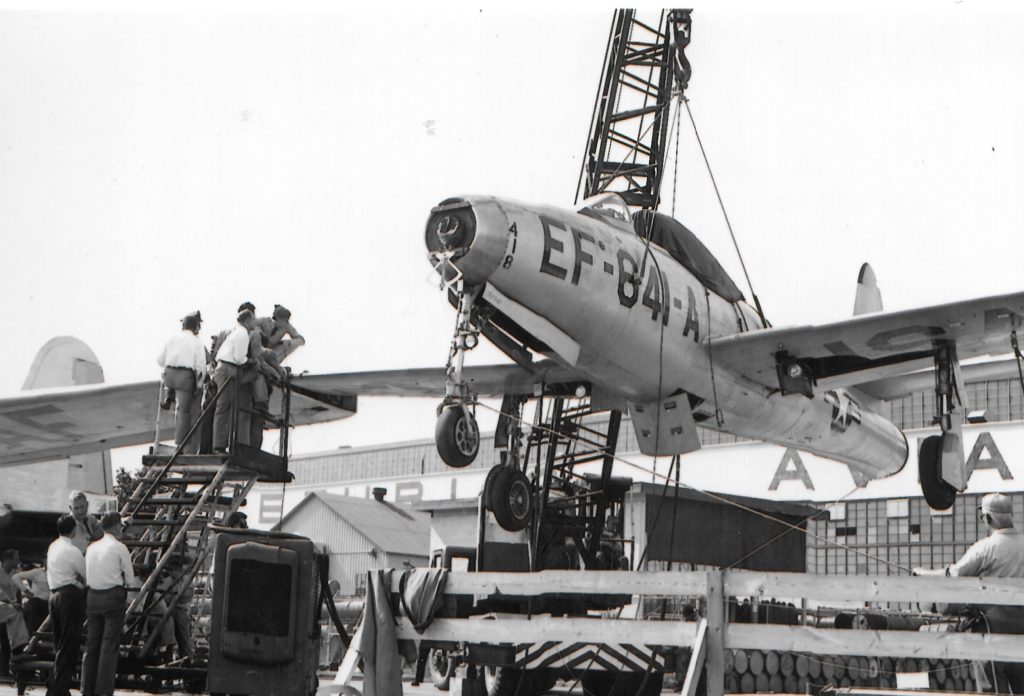
(Above left and below) The two views of the right-hand and left-hand EF-84Bs being hoisted into position for the ground testing of the coupling with the ETB-29A.
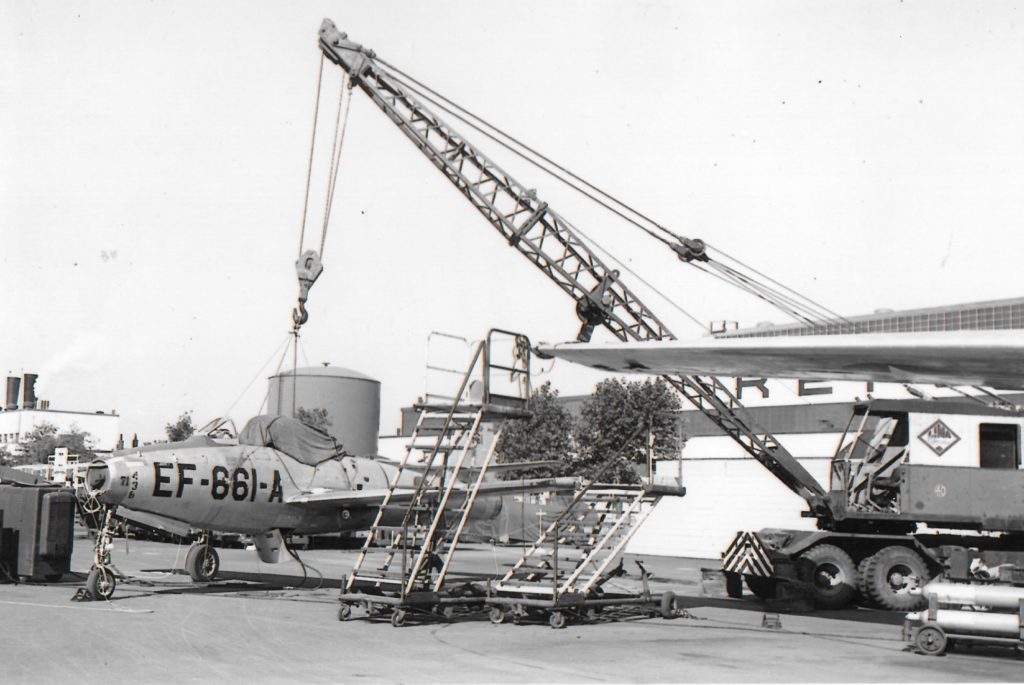
Control of the F-84 while engaged in the receiver at the extended position was no major problem; however, the aircraft was free to roll, pitch and yaw about the contact point. Any quick control movements could set up this structural oscillation, so you always felt better once retracted and locked. In the retracted position for towing, power would be reduced to idle or to engine cut-off. The aft lock held the F-84 firmly in yaw, and the only motion would be a flapping action up or down as the F-84 rolled about the longitudinal attachment line between the wingtips. We soon found that the aileron control was not sufficient to maintain the desired position. The elevator was, of course, very effective, but now, since the wingtips were locked in pitch, the proper attitude was maintained by twisting the B-29 wing structure to some degree.
The mechanical hydraulic aileron-lance interconnect system was activated and checked, but was found to be inadequate. This system was soon deactivated for the rest of the program. We had a few emergency disconnects until the flapping limits were properly adjusted and some difficulty was encountered with the lance receiver engagements due to close fit tolerance and bent locking tips. Also, the receiver would tend to turn when bumped and would not re-center itself properly. The tolerances were opened up with a file and spring snubbers were added to keep the receivers centered.
The left-hand F-84, piloted by major John M. Davis, started to make engagement attempts on flight number three. Many engagements were made, but because of the mechanical problems mentioned, full-scale dual towed flight with both F-84s in the locked position did not occur until flight number 10 on 15 September, 1950. Two complete cycles were accomplished and dual towed flight totaled about 30 minutes. Towed flight was accomplished with the F-84 engines in idle power, as well as shut down. The F-84 engine would continue to windmill when shut down, since there was no means to cut off the air flow through the air inlet. No problems were encountered with the air starts of the F-84 engines. Shallow banks were accomplished with the two fighters hooked up but, at the boom extended position. We quickly learned that we didn’t like that, because in the extended position both fighters were free in pitch, roll and yaw, and any upsetting motion would start both fighters oscillating about the hook-up point. We found that the best procedure was to get hooked up and into the retracted and locked position as soon as possible.
On flight number 11, the single aileron idea was attempted. The intent was to disable, the inboard aileron, which actually was providing adverse roll control about the coupled axis. By disconnecting the inboard aileron, it was hoped the outboard aileron would provide sufficient rolling power to control the flapping angle. Single aileron engagements were more difficult, but successful engagements and towed flights were accomplished. As was discovered previously in the Q-14 experiments, single aileron operation improved roll control, but it sill was not sufficient to maintain the proper flapping angles during maneuvering flight. The elevators provided the primary control, but in the case of the F-84/B-29 combination, this was accomplished by twisting the B-29 wing structure. Loads were measure in the outer wing panels and were not found to be excessive.
Flight 12 was flown to obtain performance data in dual towed flight. Both fighters coupled up were locked in tow for approximately 1 hour 4o minutes. Banks of 10 degrees were made both left and right. Speed power calibrations were accomplished at 20,000, 15,000 and 10,000 feet. Airspeed was varied from 195 to 156 knots. The fighters stayed coupled for the entire flight including the let-down to lower altitudes. Unfortunately, the data recorder failed, so we went back the next day (20 October 1950) and repeated the flight, this turning out to be the longest dual towed flight, approximately 2 hours 40 minutes. The performance data profile was repeated and this time the data were recorded. That flight concluded the documented portion of the flight test program and a report was published by the Republic Aviation Corporation, which clearly proved the induced drag reduction benefits of wingtip coupling
A summary of the test accomplishments during the contract documented program showed 43 individual couplings by two pilots, and 15 hours of towed flight, counting both single and dual tow. The longest dual towing flight was just over 1 ½ hours in duration. Towing appeared feasible in smooth air. The concept was validated with quantitative data showing that a bomber could tow two fighters on its wingtips with a very small degradation in range.
From the performance data gathered during the two long dual towed flights, a drag polar curve was generated and showed that at higher gross weight and lower airspeeds, the B-29/F-84 combination was more efficient than the B-29 alone; however, at low gross weight and high airspeed, the B-29 alone had the best performance characteristics. The floating panel concept was certainly validated by this study.
From the drag and performance data collected, range missions were calculated to provide a comparison of typical B-29 missions. The basic B-29-alone mission was shown as a baseline. Carrying the two F-84s on an identical profile resulted in range loss of only 7.5 percent. However, if the profile was optimized for the aerodynamic configuration of dual towing by cruising at a lower altitude, only a 2.9 percent range loss was experienced. Theoretical studies actually predicted a very slight increase in B-29 range, and perhaps with a refinement of the air seals between the wingtips, this might have been true.
System improvement
After the conclusion of the documented flight test program, Republic Aviation Corporation was awarded a follow-on contract to update the configuration and to incorporate a more sophisticated automatic flight control system. While the new system was in design phase the three aircraft remained at Wright Field, where some additional undocumented flights were accomplished: for example, night engagements were demonstrated. The test program became active again in the early part of 1953. The two fighters were modified with provisions for closing the air inlet to the engines to reduce wind milling drag, and an adjustable rear latch was incorporated to eliminate the wing twist.
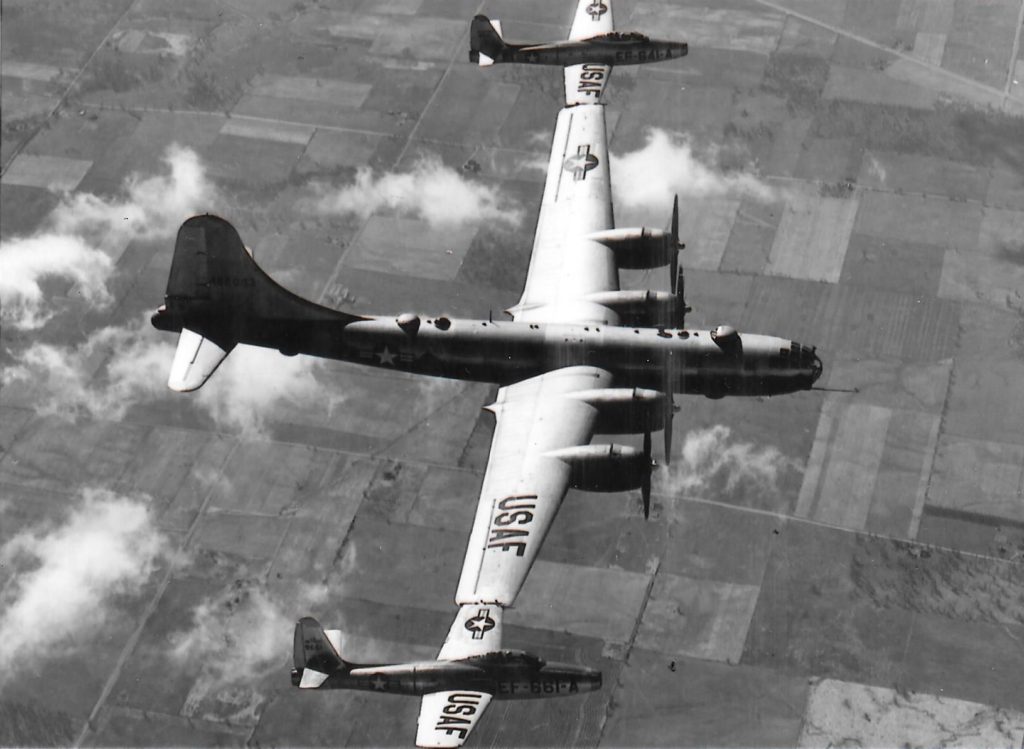
Another view of the B-29/F-84 combination in coupled flight. Tragically, the B-29, one of the F-84s and all the crew members were lost on 24 April 1953, when an attempt was made to use an automatic flight control system on the port side fighter, with the other fighter uncoupled.
The major change was the modification of all three aircraft with an electronic automatic flight control system. A master control box was carried in the B-29. This unit was to provide the central reference point. Each fighter’s position was monitored through sensing devices, and if out of position, an electronic signal was sent out to the F-84’s automatic flight control system, commanding flight control movements to maintain the proper flapping angle. The big part of the program would be devoted to the development of the automatic flight control system, finding the damping frequencies and setting up the proper autopilot settings.
There was always some doubt in my mind about how this could ever be accomplished. I had participated in some basic autopilot development flight tests in the past, one of the accepted test procedures was to set up the desired flight conditions, turn on the autopilot, then induce about a 1 g pitch conditions, turn on the autopilot, then induce about a 1 g pitch pulse, and let go while measuring the system’s damping ability. The test would be repeated many times with different damping ratios set into the autopilot until the system was refined. During the design phase, an autopilot engineer confirmed my worst fears that this technique would be required to develop, check out, and set up the B-29 wingtip towing automatic flight control system. I could not envision ever making a pitch pulse of any magnitude while coupled in towed flight, nor could I visualize letting go of the control stick if there was any flapping action going on at all. The tremendous power of the F-84 elevator was very apparent to both fighter pilots. Pitch control was treated with great respect and with full anticipation of the consequences.
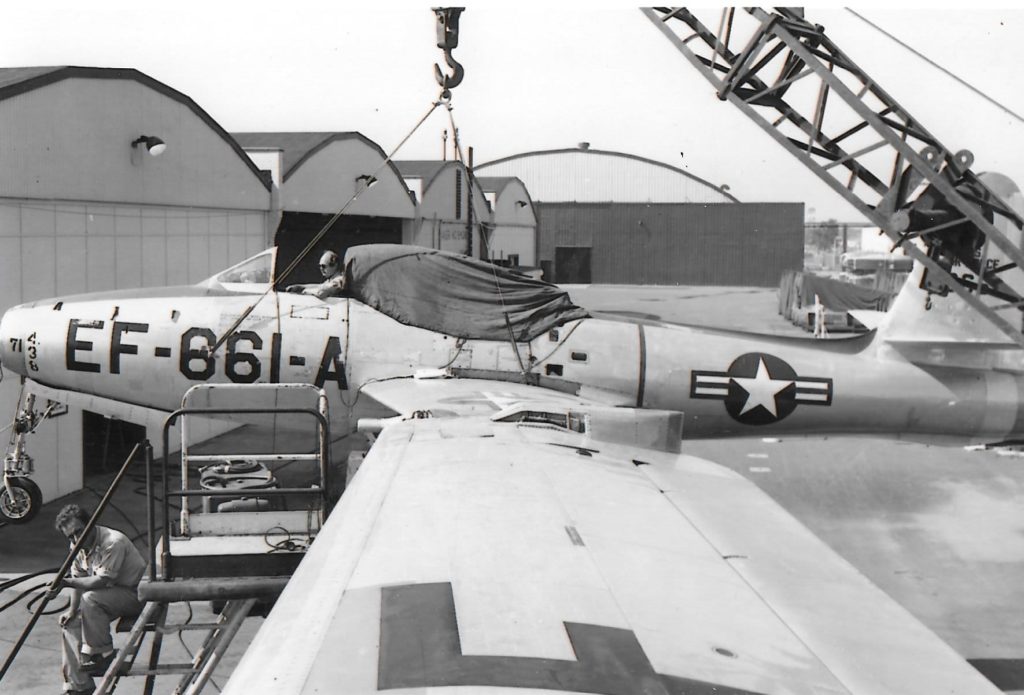
Additional illustrations showing the coupling of the F-84 to the B-29 during ground testing.
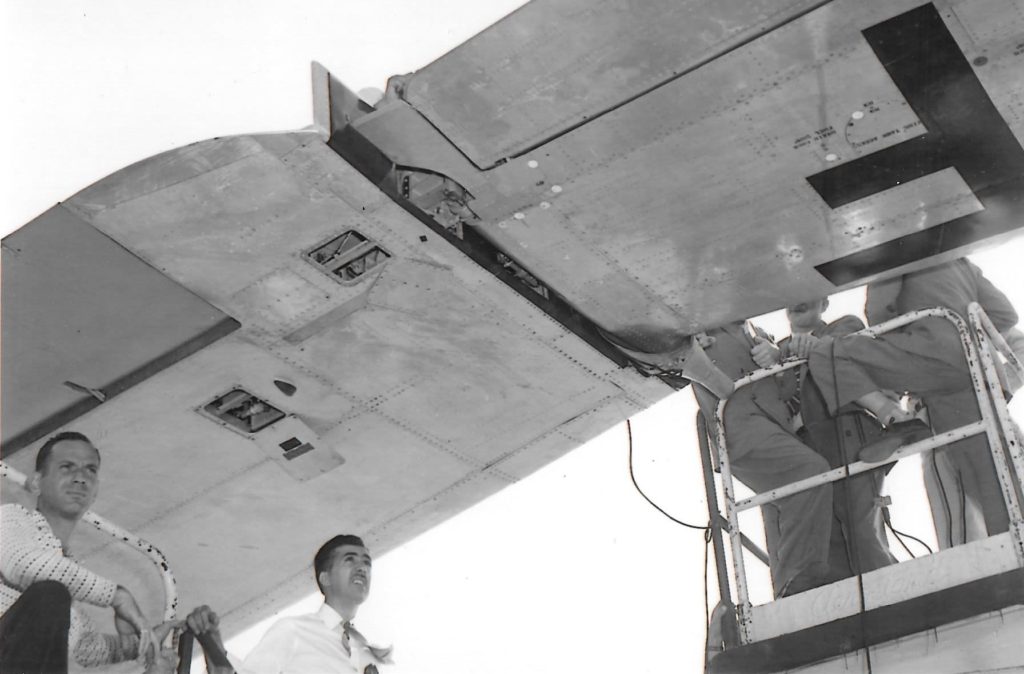
I had by this time been transferred to desk duty at the Pentagon, so lost interest until one day when I was recalled to help out on the preliminary check-out flights at Farmingdale, Long Island. The right-hand F-84 was the fully instrumented fighter, so all initial checks generally had been made with it in order to obtain data. As I recall, six flights were made during March and April of 1953. The new systems were checked out individually, and single coupled and towed flight was accomplished. Electrical power from the B-29 could never be received in the right-hand fighter, but had been consistently available in the non-instrumented left-hand F-84. Both F-84 autopilots were set up identically for the initial flight control system test. So, it was agreed that on the next flight, if power was again not available on the right-hand fighter, the automatic flight control system would be activated momentarily using the left-hand fighter.
The next test flight was on 24 April, 1953. A coupling and fully towed flight was accomplished using the right-hand F-84; however, again no electrical power was received from the B-29. The right-hand uncoupled, and the left-hand fighter, again piloted by Major John Davis, coupled with the B-29 and was retracted in the fully locked towing position. The cockpit panel light indicated that electrical power was available from the B-29 source, so as soon as everything was trimmed and stabilized, the automatic flight control system was activated momentarily from the fighter. This action resulted in a violent pitching motion of the F-84, causing it to flap up and inward into the B-29. The B-29 outer wing panel crumpled as the F-84 rolled inward and went inverted, struck the B-29 main wing spar, shearing off the F-84 nose section forward of the cockpit, before the two aircraft separated. The B-29 went into a steep spiral and crashed into Peconic Bay, Long Island, and the F-84 crashed shortly thereafter; no crew members survived from either aircraft.
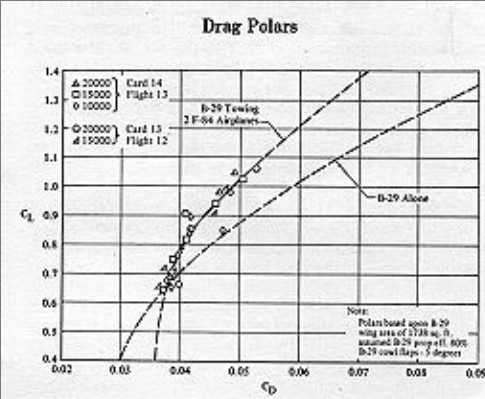
The disastrous accident put a large damper on the entire concept. However, two other major projects were conducted before all interest was eventually lost. During the 1952-53, there was a project conducted under contract entirely by the General Dynamics Corporation Convair Division, at Ft. Worth. This project, code named “Tom-Tom,” involved the wingtip coupling of an RB-36F with two swept-wing RF-84F fighters. Then, in the 1955-56 time period, Beechcraft was awarded a contract to build, install, and test a set of small fuel-carrying wingtip “floating panel” extensions on a military Beech L-23. The project, code named “Long Tom,” was successfully completed, and a significant improvement in range was demonstrated
In summary, it had been shown that the “floating wing panel” concept had been validated. Technical problems still exist, particularly in the area of stability and control, structural dynamics, and automatic flight. These problems may have been compounded by other technological advances such as supersonic flight, since the B-29/F-84 tests. Today’s practical application of fighter towing concept appears to be somewhat vague; however, Dr. Vogt’s aerodynamic invention which provided “something for nothing,” is still available. Perhaps with the energy crunch of the 1980s upon us, the range-extension application is more pertinent today than it ever was. I recall that the first in-flight refueling experiments were conducted in the 1920s, but this technique did not receive widespread application until the Strategic Air Command adopted in-flight refueling as a standard day-to-day operation in the 1950s.
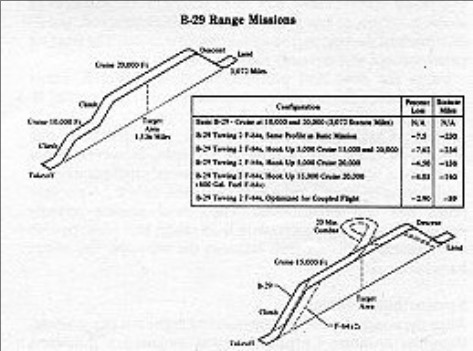
1949 USAF film clip of Bud Anderson flying the Q-14 during wingtip coupling experiments with a C-47
USAF film clip of Bud Anderson flying the F-84 during wing coupling experiments with a B-29.
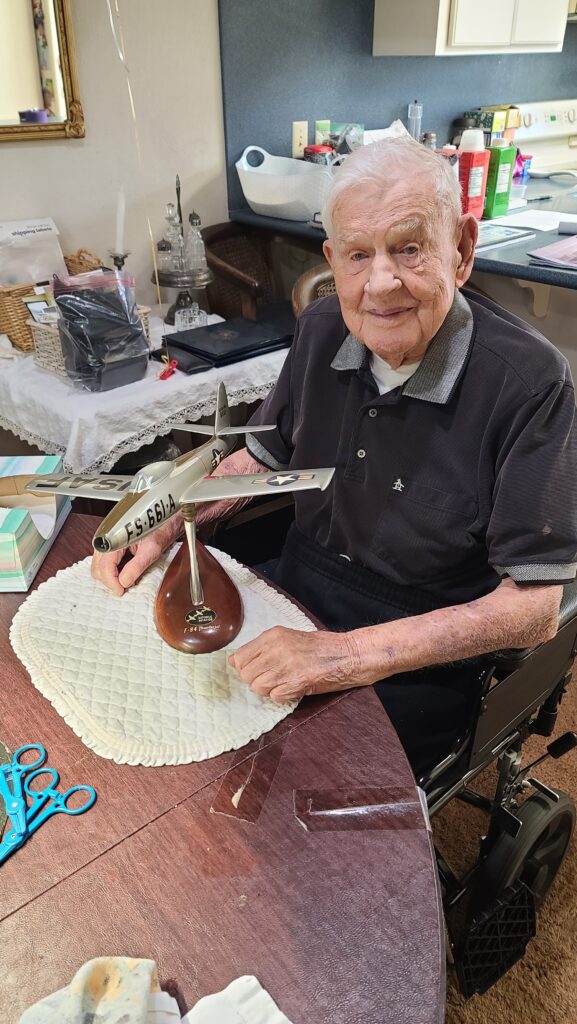
Bud Anderson with Republic Aviation model of his EF-84B used in the wingtip coupling flight tests.
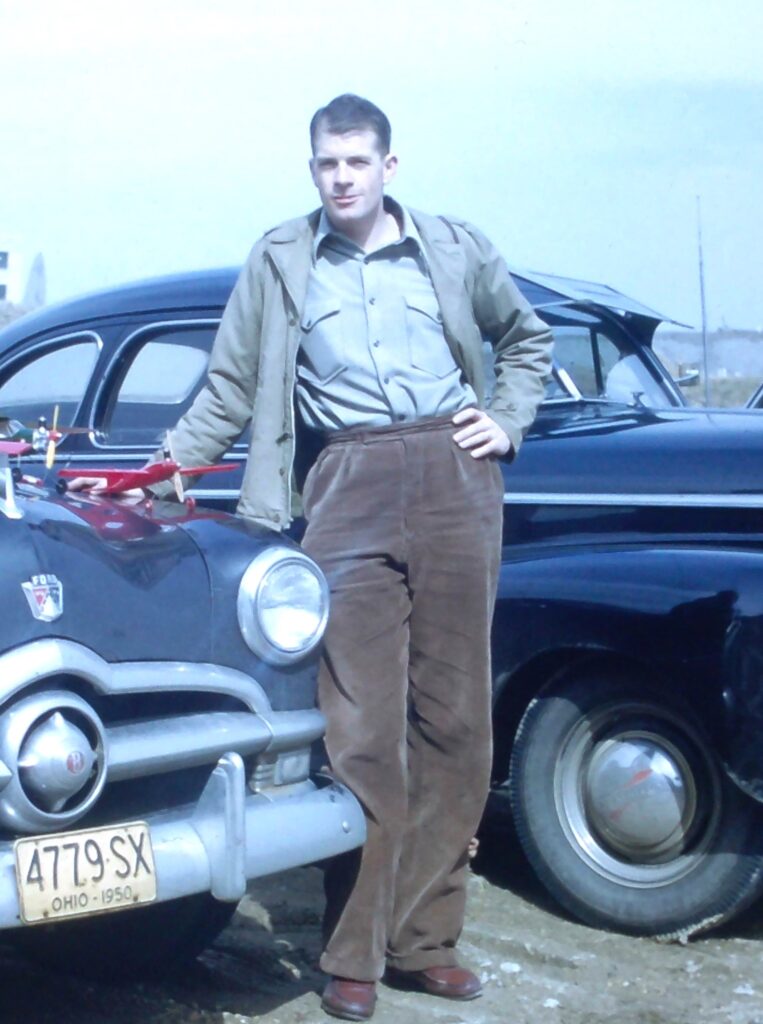
In Memory of Test Pilot Major John Davis, killed on 24 April 1953 during the F-84/B-29 Wing Coupling Flight Testing. Photo from Rick Johnson

